As the world of culinary appliances continues to evolve, electric grills have emerged as a favorite among consumers in both Europe and the United States. These versatile cooking devices offer a blend of convenience, efficiency, and the ability to replicate the authentic flavors of traditional barbecue. This article delves into the reasons behind their popularity, the latest market trends, technological advancements, the impact of sustainability, a comparative analysis with traditional barbecue methods, the challenges and opportunities in the industry, and a look at successful electric grill brands that have captured the hearts of consumers across the pond.
The Rise of Electric Grills in the Western Markets
The electric grill has seen a remarkable surge in popularity across Western markets, becoming a staple in many households. This rise can be attributed to several factors that have converged to make electric grills a convenient and desirable choice for cooking enthusiasts and casual chefs alike.
One of the primary reasons for the electric grill’s ascent is the shift towards healthier eating habits. With an increasing focus on diet and wellness, consumers are seeking cooking methods that minimize the addition of unhealthy fats. Electric grills, with their ability to cook food with minimal oil, offer a healthier alternative to traditional grilling methods. This health-conscious trend has been particularly prominent in Europe, where there’s a strong emphasis on balanced lifestyles.
The convenience factor cannot be overstated. Electric grills are portable, easy to use, and require minimal maintenance. They eliminate the need for charcoal or gas, reducing the cleanup and the potential for flare-ups. This ease of use has made electric grills a favorite among busy professionals and families who value time-saving appliances. The compact size also means they can be stored away easily, making them a practical choice for smaller living spaces.
Modern technology has played a pivotal role in the rise of electric grills. Innovations such as adjustable temperature controls, digital displays, and automatic shut-off features have made these grills more user-friendly and versatile. Consumers now have the ability to achieve the perfect sear on their meats and vegetables with precision, thanks to these technological advancements. This level of control and convenience has significantly broadened the appeal of electric grills.
Another driving force behind the popularity of electric grills is the growing preference for outdoor living spaces. With the increase in urbanization and the desire for more outdoor activities, people are looking for ways to enjoy their patios, balconies, and gardens. Electric grills provide a solution that doesn’t require the installation of gas lines or the hassle of dealing with smoke and ashes. They allow for a seamless transition from indoor to outdoor cooking without the drawbacks of traditional grilling.
In the United States, the electric grill market has been bolstered by the rise of health food trends and the growing number of people who prefer to cook at home. The convenience of electric grills has also been a factor, as they are often used in apartments and condos where gas grills are not allowed. The variety of electric grill models available, from compact countertop units to larger outdoor grills, caters to a wide range of consumer needs and preferences.
Moreover, the electric grill industry has seen a surge in eco-friendly models. As sustainability becomes a more critical issue for consumers, brands are responding by offering electric grills that are energy-efficient and have a smaller carbon footprint. This shift towards greener appliances is not only beneficial for the environment but also aligns with the values of a socially conscious consumer base.
The competitive landscape of the electric grill market is also evolving. Brands are constantly introducing new features and designs to differentiate themselves. From grills with built-in smokers to those with infrared heating elements, the variety of options is vast. This competition has led to better quality products and more affordable prices, making electric grills accessible to a broader audience.
In conclusion, the rise of electric grills in Western markets is a multifaceted phenomenon. It’s driven by health and wellness trends, technological advancements, the popularity of outdoor living, and the demand for eco-friendly products. As these factors continue to influence consumer behavior, it’s clear that electric grills are here to stay, offering a convenient and enjoyable cooking experience for years to come.

Understanding the European and American Culinary Cultures
The culinary landscapes of Europe and America are as diverse as they are distinct, each shaped by historical influences, regional flavors, and the evolving tastes of their populations. In the realm of cooking, these two continents offer a tapestry of traditions that have significantly influenced the way electric grills are embraced and utilized.
European culinary cultures are a rich blend of ancient recipes and modern techniques. From the sun-drenched Mediterranean coast, where olive oil and fresh herbs dominate, to the hearty dishes of Northern Europe, which often feature locally sourced ingredients and a focus on simplicity, there’s a clear appreciation for the quality of food. The electric grill has found a niche in this environment, particularly in countries like Italy, Spain, and the UK, where outdoor cooking is a favorite pastime. These regions have a tradition of communal dining and the electric grill offers a convenient way to achieve that without the need for charcoal or gas, making it an ideal choice for balconies and patios.
In America, the culinary scene is a melting pot of global flavors, reflecting the country’s diverse ethnic heritage. From the soulful flavors of Southern BBQ to the gourmet creations of California’s foodie scene, American cooking is as varied as it is bold. The electric grill has become a staple in American households, especially in urban settings where space is at a premium. Its ease of use and clean burn make it a favorite for those who enjoy cooking but prefer not to deal with the messiness of traditional grilling methods.
The European culinary tradition is steeped in the use of fresh, seasonal ingredients. Chefs and home cooks alike value the purity of flavors and the importance of sourcing local produce. Electric grills have been integrated into this ethos by offering a means to quickly and efficiently cook ingredients without altering their natural taste. The convenience of electric grills is particularly appealing to the health-conscious demographic in Europe, as they often provide a healthier option compared to deep-frying or cooking in oil.
In America, the culinary landscape is marked by a love for bold and sometimes spicy flavors. The electric grill has played a role in this by enabling the creation of a variety of dishes that range from classic burgers and steaks to exotic dishes like Latin American skewers and Asian-style teriyaki chicken. The versatility of electric grills has allowed American chefs to experiment with different cooking techniques and ingredients, making them a staple in both professional kitchens and home cooking.
Both European and American cultures place a strong emphasis on the social aspect of dining. In Europe, outdoor dining is a way of life, with cafes and restaurants often extending their seating into the streets or gardens. Electric grills have become a popular feature in these settings, as they can be easily placed on a table or balcony, allowing for impromptu gatherings and the sharing of food. In America, the backyard barbecue is a cherished tradition, and electric grills have made it possible for this experience to be enjoyed year-round, regardless of weather conditions.
The rise of electric grills in both Europe and America can also be attributed to the growing trend of urbanization. As cities expand and space becomes more limited, the electric grill offers a practical solution for those who want to enjoy the experience of grilling without the need for a dedicated outdoor space. This is particularly true in Europe, where cities like London and Paris have seen a surge in the popularity of electric grills among urban dwellers.
In summary, the European and American culinary cultures differ in their approaches to cooking and dining, but both have embraced the electric grill as a versatile and convenient cooking tool. Whether it’s for a quick meal on a balcony, a communal gathering, or a gourmet feast, the electric grill has become a symbol of the modern kitchen, bridging the gap between traditional cooking methods and the demands of modern life.

Why Electric Grills Have Gained Popularity
Electric grills have seen a remarkable surge in popularity across the Western markets, and this trend isn’t just a fleeting fad. Several factors contribute to their growing appeal, each addressing different aspects of modern lifestyle and consumer preferences.
The convenience factor is a significant driver. Electric grills are, by nature, easy to use and maintain. With no need for charcoal or gas, they eliminate the complexities and cleanup involved with traditional barbecue methods. Users can simply plug them in, preheat them, and start cooking, making them an ideal choice for those who lack the time or patience for more involved grilling processes.
Moreover, electric grills offer a level of control that many find appealing. The precise temperature regulation allows for more consistent results, which is particularly important for those who are less experienced in grilling or who prefer a perfectly cooked meal every time. This control also means that users can achieve a variety of cooking styles, from searing steaks to slow-cooking vegetables, all on the same appliance.
Safety is another key consideration. Traditional grilling involves open flames and the risk of flare-ups, which can be hazardous, especially in urban settings or small living spaces. Electric grills, on the other hand, eliminate this risk, making them a safer option for families and individuals who want to avoid the potential dangers associated with gas or charcoal grills.
The versatility of electric grills is also a major draw. They come in a range of sizes and styles, from countertop models perfect for small apartments to larger outdoor grills that can accommodate large gatherings. This variety allows consumers to choose a grill that fits their specific needs and living arrangements, be it a compact unit for occasional use or a full-sized grill for regular entertaining.
In recent years, there has been a growing emphasis on health and wellness, and electric grills have responded by offering healthier cooking options. Unlike traditional grills, which often require the use of oils and fats to prevent sticking, electric grills can be used with non-stick surfaces or cooking sprays, reducing the amount of fat used in cooking. This not only makes the food healthier but also easier to clean up.
Environmental consciousness has also played a role in the popularity of electric grills. As awareness of climate change and sustainability grows, consumers are increasingly seeking out products that have a lower carbon footprint. Electric grills, being energy-efficient and producing fewer emissions than gas or charcoal grills, align with these eco-friendly values.
The integration of technology into everyday appliances has become a norm, and electric grills are no exception. Many modern electric grills come with smart features such as temperature control apps, Bluetooth connectivity, and even voice command compatibility. These technological advancements not only enhance the user experience but also cater to the tech-savvy consumer who appreciates the convenience of having their grill integrated with their smart home system.
Additionally, the rise of outdoor living spaces has spurred the demand for electric grills. With more people investing in patios, decks, and gardens, having a reliable and efficient way to cook outdoors has become a priority. Electric grills fit this need perfectly, providing a convenient and easy-to-use solution for those who want to enjoy the outdoors without sacrificing the convenience of cooking at home.
Lastly, the culinary landscape itself has evolved, with an increasing number of people seeking out diverse and international flavors. Electric grills offer the flexibility to experiment with various cooking techniques and recipes, allowing for a wider range of dishes to be prepared. From authentic Mexican fajitas to Japanese yakitori, the versatility of electric grills has made them a favorite among culinary enthusiasts.
In summary, the popularity of electric grills in the Western markets can be attributed to their convenience, control, safety, versatility, health benefits, environmental considerations, technological integration, and the evolving culinary landscape. These factors have combined to create a product that appeals to a broad spectrum of consumers, making electric grills a staple in many modern kitchens.
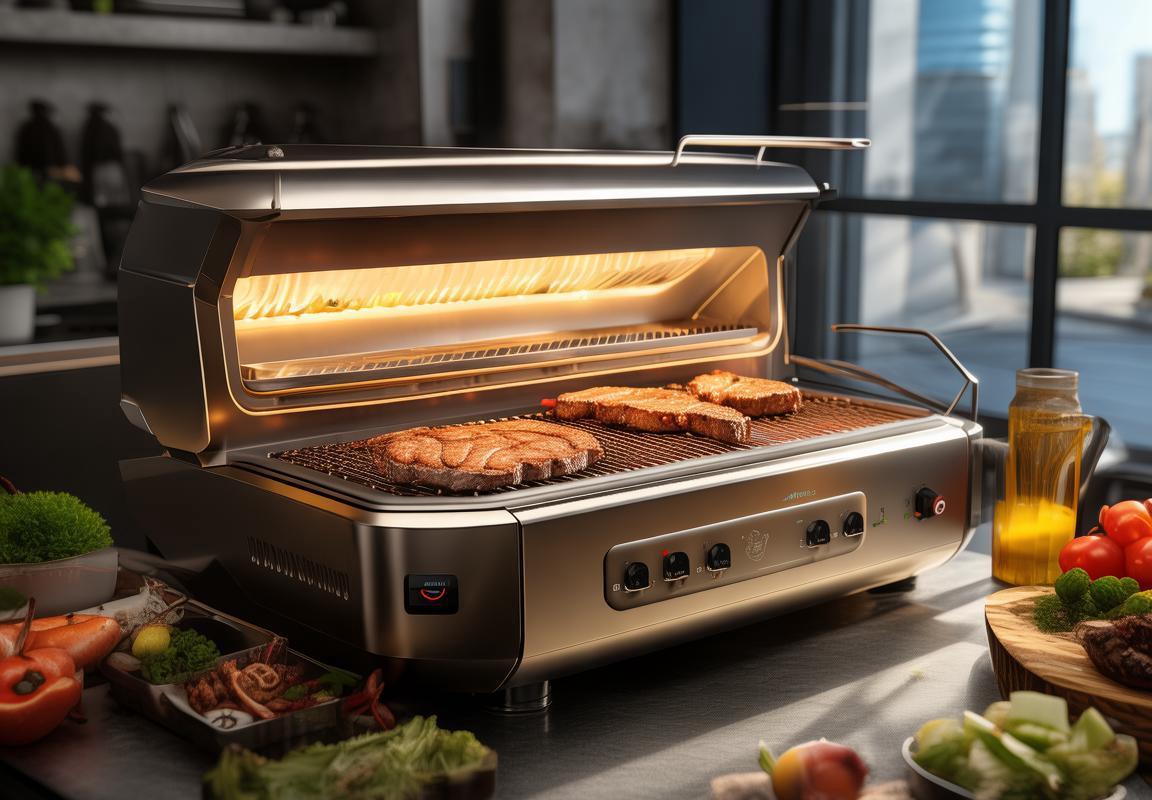
Key Market Trends and Consumer Preferences
In the ever-evolving landscape of kitchen appliances, electric grills have surged in popularity, and understanding the driving forces behind this trend is crucial. Here’s a closer look at the key market trends and consumer preferences that have propelled electric grills to the forefront.
The shift towards convenience is a significant factor in the rise of electric grills. Modern lifestyles are fast-paced, and consumers are increasingly seeking appliances that save time and effort. Electric grills offer a quick and easy way to cook, eliminating the need for charcoal or gas, and reducing the preparation time compared to traditional outdoor grilling.
Health consciousness is another major driver. With a growing awareness of the benefits of grilling over frying, consumers are opting for electric grills that allow for healthier cooking methods. The ability to control the heat and cook at lower temperatures reduces the risk of charring, which can lead to the formation of harmful compounds.
Smart technology integration has become a staple in many kitchen appliances, and electric grills are no exception. Features like digital temperature controls, Bluetooth connectivity for monitoring on a smartphone, and programmable settings have made electric grills more appealing to tech-savvy consumers who appreciate the fusion of cooking and technology.
The versatility of electric grills is undeniable. These appliances can be used indoors or outdoors, making them suitable for a variety of settings, from apartments to patios. This adaptability caters to consumers who may not have access to a traditional outdoor grill or who prefer the convenience of cooking in their own space.
Eco-friendly consumers are also drawn to electric grills. They are often perceived as more environmentally friendly than gas or charcoal grills, as they don’t require the use of fossil fuels. The absence of open flames also reduces the risk of wildfires, a concern in many regions.
The rise of health-focused cooking shows and recipes has influenced consumer preferences. With chefs and influencers promoting the benefits of grilling, consumers are more likely to invest in electric grills that can help them replicate restaurant-quality dishes at home.
The demand for variety in cooking experiences has spurred the development of electric grills with different surface materials and cooking technologies. From ceramic to infrared, these variations cater to consumers who want to experiment with different flavors and cooking outcomes.
The convenience of cleaning is a subtle yet significant preference. Electric grills typically have non-stick surfaces and can be cleaned with water and mild detergent, which is more appealing to busy individuals who prefer appliances that require minimal maintenance.
The rise of electric grills has also been fueled by the desire for portability. Compact and lightweight designs have made these grills a favorite among travelers and those with limited space. The ability to take an electric grill on a camping trip or to a friend’s house for a social gathering adds to their appeal.
Lastly, the social aspect of cooking cannot be overlooked. Electric grills encourage outdoor dining and social gatherings, which are cherished by many consumers. The ease of use and the ability to cook a variety of foods make them a centerpiece for hosting and entertaining.
In summary, the popularity of electric grills is a multifaceted trend driven by convenience, health, technology, versatility, sustainability, and social factors. As these preferences continue to evolve, electric grill manufacturers are likely to innovate further, ensuring that these appliances remain a staple in contemporary kitchens.
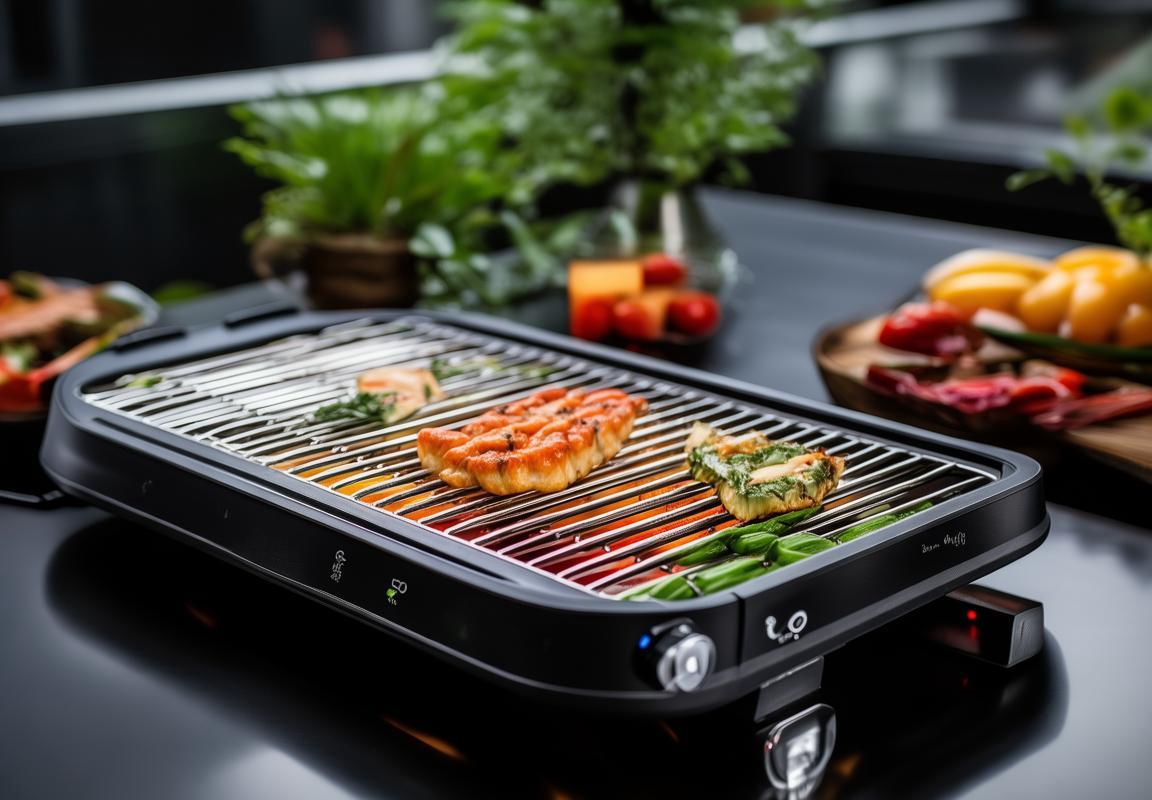
Innovations in Electric Grill Technology
Electric grills have seen a remarkable evolution in technology, transforming from simple appliances to sophisticated cooking tools. Here’s a delve into the innovations that have propelled electric grills to new heights of popularity:
-
Smart Control Panels: Modern electric grills are equipped with intuitive control panels that allow users to precisely manage temperature settings. These panels often include digital displays and buttons for adjusting heat levels, preheating times, and cooking modes, ensuring that the grill is always ready for the perfect cook.
-
Temperature Sensors and Monitoring: One of the standout innovations is the integration of temperature sensors. These sensors provide real-time feedback on the grill’s internal temperature, helping chefs maintain consistent heat throughout the cooking process. Some models even have Bluetooth connectivity, allowing users to monitor their grills from a smartphone app.
-
Variable Heat Zones: Electric grills with variable heat zones offer a more versatile cooking experience. Users can adjust the heat on different sections of the grill, enabling searing on one side while keeping another side at a lower temperature for indirect cooking. This feature is particularly beneficial for grilling multiple types of food simultaneously.
-
Non-Stick Coatings: The development of advanced non-stick coatings has made cleaning electric grills much easier. These coatings reduce the likelihood of food sticking to the grill surface, ensuring that cleanup is a breeze after a cookout.
-
Eco-Friendly Materials: Environmental consciousness has led to the use of more sustainable materials in electric grill construction. From stainless steel components to recycled plastics for handles and controls, manufacturers are increasingly focusing on reducing their carbon footprint.
-
Drip Trays and Grease Management: Innovations in grease management have significantly improved the cooking experience. Many electric grills now come with deep, removable drip trays that catch excess fat and grease, reducing flare-ups and making it easier to dispose of the byproducts.
-
Built-In Thermometers: Some high-end electric grills are fitted with built-in thermometers that provide accurate temperature readings. This feature is especially useful for ensuring that meats reach the perfect internal temperature for safety and tenderness.
-
Cooking Grates and Grids: The design of cooking surfaces has seen advancements as well. Some grills now offer replaceable cooking grids and grates, which can be customized for different types of cooking. Cast iron grates, porcelain-coated surfaces, and stainless steel grids all offer unique benefits in terms of heat retention, non-stick properties, and ease of cleaning.
-
Automatic Ignition Systems: The days of struggling with matches or lighters to ignite an electric grill are over. Many models now feature automatic ignition systems, making it as easy as flipping a switch to start cooking.
-
Portable and Compact Designs: Electric grills have become more portable and compact, making them perfect for outdoor enthusiasts who enjoy grilling on the go. Collapsible legs, foldable handles, and lightweight materials have all contributed to the convenience of these appliances.
-
Versatile Cooking Options: Innovations have expanded the range of cooking options available on electric grills. From direct heat grilling to indirect smoking, these appliances can now replicate the flavors and textures of traditional charcoal or gas grills.
-
Safety Features: Electric grills have incorporated various safety features to prevent accidents. These include cool-touch handles, child safety locks, and automatic shut-off functions that activate if the grill is left unattended for an extended period.
The evolution of electric grill technology has made these appliances more user-friendly, versatile, and efficient. As consumers continue to seek convenience and innovation in their cooking tools, electric grills are poised to maintain their popularity, offering a convenient and enjoyable grilling experience for both casual and seasoned chefs alike.

The Impact of Sustainability on Electric Grill Sales
Electric grills have seen a significant surge in popularity, not just for their convenience but also for their environmental benefits. The impact of sustainability on electric grill sales is multifaceted, intertwining with consumer values and market dynamics.
The Shift Towards Eco-Friendly AppliancesConsumers are increasingly concerned about the environmental impact of their purchases. As a result, there’s been a noticeable shift towards eco-friendly appliances, including electric grills. These grills, often powered by electricity from renewable sources, offer a greener alternative to traditional charcoal or gas grills that emit greenhouse gases and contribute to air pollution.
Energy Efficiency and Cost SavingsElectric grills are known for their energy efficiency. They consume less power than gas grills and can be more cost-effective in the long run. With the rising cost of fuel and the desire for energy conservation, consumers are gravitating towards electric grills as a more sustainable and economical choice.
Reduced Carbon FootprintThe carbon footprint of electric grills is generally lower than that of gas or charcoal grills. By using electricity, which can be sourced from renewable energy sources, these grills help reduce the overall carbon emissions associated with cooking. This appeal to eco-conscious consumers has been a significant driver in the growth of electric grill sales.
Health and Safety ConsiderationsSustainability isn’t just about the environment; it also encompasses health and safety. Electric grills are often considered safer than gas grills, which can pose risks of gas leaks and explosions. Additionally, the absence of smoke and ash from charcoal grills makes electric grills a healthier option for those with respiratory issues or allergies.
Innovations in Sustainable MaterialsManufacturers are responding to the demand for sustainability by using eco-friendly materials in the construction of electric grills. Biodegradable plastics, recycled metals, and sustainable woods are being integrated into the design of these appliances, further enhancing their appeal to environmentally conscious consumers.
Government Incentives and RegulationsIn many regions, governments are offering incentives for the purchase of energy-efficient appliances, including electric grills. These incentives, such as tax rebates or discounts, can significantly boost sales by making sustainable options more affordable. Moreover, regulations that limit the use of certain fuels or emissions can also influence consumer preferences and drive sales of electric grills.
Brand Perception and MarketingBrands that emphasize sustainability in their marketing campaigns are gaining a competitive edge. By highlighting the eco-friendly aspects of their electric grills, manufacturers can attract consumers who are looking for a product that aligns with their values. This brand perception plays a crucial role in the success of electric grill sales.
Global Trends and Cultural ShiftsThe rise of electric grills is not confined to a single region. Global trends, such as the growing middle class in developing countries, are contributing to the increased demand for these appliances. Additionally, the cultural shift towards outdoor living and entertaining has made electric grills a must-have for many consumers who want to enjoy the benefits of grilling without the environmental drawbacks.
Consumer Education and AwarenessEducating consumers about the benefits of electric grills in terms of sustainability is key to driving sales. As awareness of environmental issues grows, consumers are more likely to research and consider eco-friendly options. This education process is often facilitated by manufacturers through informative marketing materials and online content.
The Future of Electric Grill SalesThe impact of sustainability on electric grill sales is expected to continue growing. As technology advances and consumer awareness deepens, we can anticipate even more innovative and sustainable electric grill options hitting the market. The future of electric grills is bright, with a strong focus on environmental responsibility and consumer health.
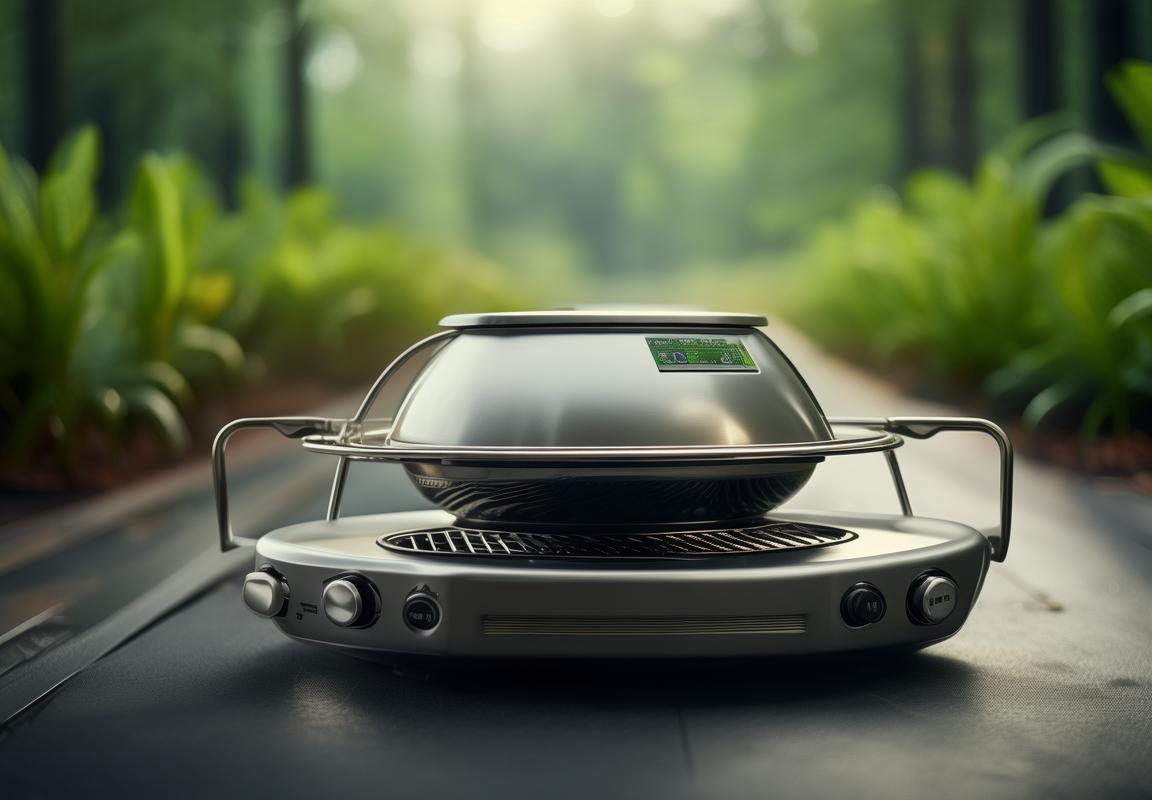
Comparative Analysis: Electric Grills vs. Traditional Barbecue Methods
Electric grills have become a staple in many kitchens, offering a convenient and efficient way to enjoy the flavors of outdoor cooking indoors. But how do they stack up against the traditional barbecue methods? Let’s delve into the comparative analysis of electric grills versus traditional barbecue.
Electric grills are a marvel of modern convenience, designed to mimic the experience of outdoor grilling in the comfort of your own home. They operate using electricity, providing a steady heat source that’s easy to control. On the other hand, traditional barbecue methods often rely on charcoal or wood as the heat source, which can impart a distinct smoky flavor to the food.
One of the primary advantages of electric grills is their ease of use. They come with adjustable temperature controls, allowing you to precisely manage the heat and cooking time. This level of control is often lacking in traditional barbecue, where the heat is more unpredictable and can vary widely depending on the weather and the quality of the fuel.
In terms of fuel, electric grills are a cleaner option. They don’t produce smoke or emissions, making them ideal for urban settings where open flames might be prohibited or frowned upon. Traditional barbecue, especially charcoal grilling, releases carbon monoxide and other pollutants into the atmosphere, which can be a concern for both health and the environment.
When it comes to cooking time, electric grills often offer a faster cooking experience. They reach high temperatures quickly and maintain them consistently, which can be particularly beneficial for those who want to prepare meals in a shorter amount of time. Traditional barbecue methods, such as smoking, can take hours to achieve the desired level of doneness and flavor development.
The design of electric grills has also evolved to include features that enhance the grilling experience. Many models now come with non-stick surfaces, making them easier to clean and reducing the need for cooking oils. Some even have built-in timers and temperature probes, which can be a game-changer for those who want to ensure their food is cooked to perfection without constant monitoring.
On the flip side, traditional barbecue has its own set of advantages. For instance, the smoky flavor that comes from charcoal or wood-fired grills is often sought after for its rich and complex taste. The process of smoking meat can also preserve it for longer periods, making it a popular choice for outdoor events and celebrations.
Charcoal grills provide a more intense heat that can sear food quickly, creating a beautiful char and developing a unique crust. This direct heat is also great for grilling vegetables and fruits, which can be difficult to achieve on electric grills without the risk of burning.
Moreover, traditional barbecue is deeply ingrained in many cultures and offers a sense of tradition and connection to the past. The ritual of lighting a fire, the smell of smoke, and the communal experience of cooking outdoors are all elements that make traditional barbecue a cherished pastime.
In terms of maintenance, electric grills are generally easier to clean due to their enclosed cooking surfaces. They require minimal cleanup, usually just a wipe-down with a damp cloth. Traditional barbecue, particularly charcoal grills, can be more labor-intensive to clean, as they often have ash and soot that need to be brushed off or swept away.
When it comes to portability, electric grills are often lighter and more compact, making them ideal for apartment dwellers or those who enjoy grilling on the go. Traditional barbecue setups, especially larger charcoal grills, can be heavy and cumbersome to move.
Despite the differences, both electric grills and traditional barbecue methods have their place in the culinary landscape. The choice often boils down to personal preference, the type of food being cooked, and the environment in which the grilling is taking place.
For those who prioritize convenience, clean-up, and precise temperature control, electric grills are the way to go. They offer a quick, easy, and consistent grilling experience that can be enjoyed year-round, regardless of weather conditions.
Conversely, for those who cherish the tradition, the flavor profile of smoke, and the communal aspect of outdoor cooking, traditional barbecue remains a compelling choice. Whether it’s a backyard barbecue or a camping trip, the smell of wood smoke and the sight of flames dancing over a fire evoke a sense of nostalgia and connection to the earth.
In the end, whether you opt for an electric grill or a traditional barbecue method, the key to a great meal lies in the quality of the ingredients, the skill of the chef, and the joy of sharing a meal with friends and family.
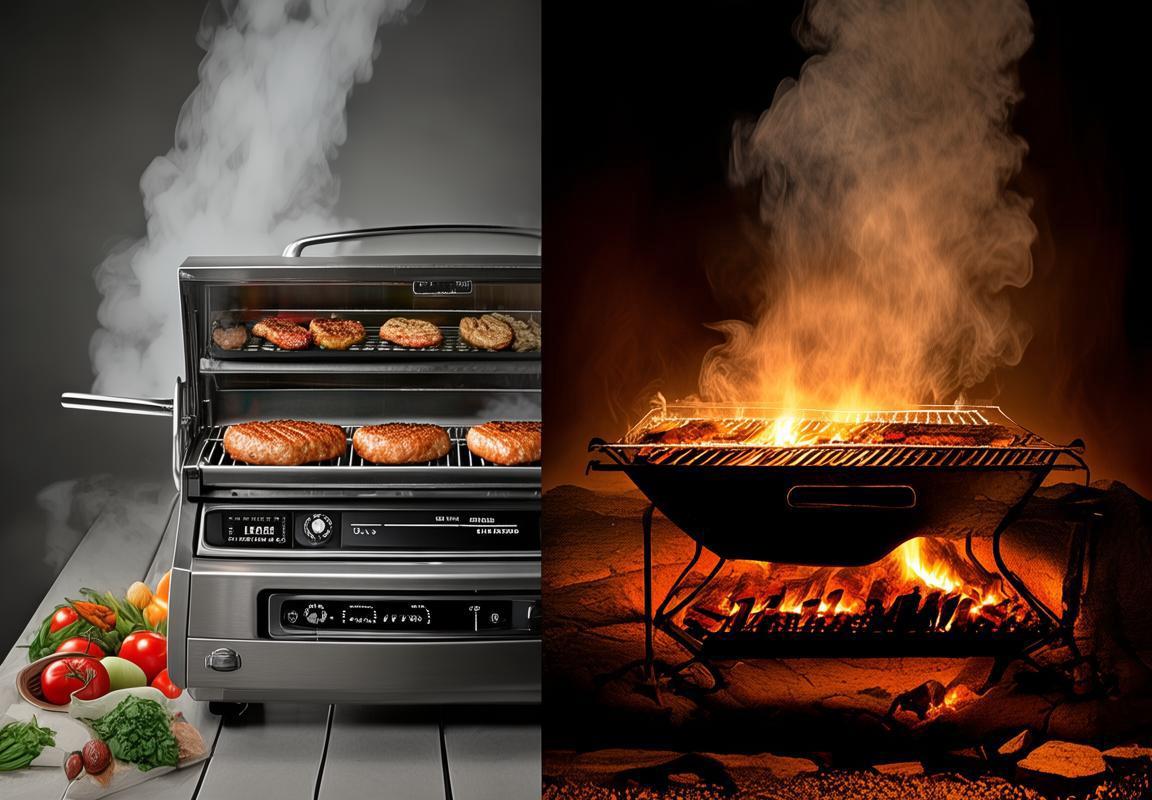
Challenges and Opportunities in the Electric Grill Industry
The electric grill industry has seen a surge in growth, but it’s not without its set of challenges and opportunities. From evolving consumer demands to technological advancements, the landscape is dynamic and ever-changing.
Consumers are increasingly seeking convenience and efficiency in their cooking appliances, and electric grills have stepped up to meet these needs. However, the industry faces the challenge of educating potential buyers about the benefits of electric grills over traditional barbecue methods. The rise of health consciousness has also brought about a shift in preferences, with consumers looking for grills that offer healthier cooking options.
Manufacturers are investing heavily in research and development to create electric grills that are not only user-friendly but also environmentally friendly. This push for innovation has opened up new opportunities, such as the integration of smart technology and the development of grills that can be controlled remotely. Despite these opportunities, the industry must navigate through regulatory hurdles and ensure compliance with safety standards.
The competition within the electric grill market is fierce, with numerous brands vying for market share. Distributors and retailers are under pressure to offer competitive pricing and a wide variety of products to cater to different consumer segments. The industry also grapples with the challenge of counterfeit products, which can undermine the credibility of legitimate brands.
One of the key opportunities in the electric grill industry is the expansion into new markets, particularly in regions where traditional barbecue is not as prevalent. This expansion requires a deep understanding of local culinary preferences and the ability to adapt products accordingly. Additionally, the industry can capitalize on the growing trend of outdoor living and entertaining, offering grills that are designed for both practicality and aesthetics.
The integration of smart features in electric grills has become a significant trend. Consumers are drawn to the convenience of being able to start their grill remotely or monitor cooking temperatures from their smartphones. This technological integration not only enhances the user experience but also allows for better control over the cooking process, reducing the risk of food spoilage or burning.
Another opportunity lies in the customization of electric grills. By offering a range of sizes, power outputs, and features, manufacturers can cater to a broader audience. For instance, smaller, portable grills are perfect for urban dwellers with limited space, while larger models can satisfy the needs of families or those hosting large gatherings.
The rise of health and wellness has also created a niche market for electric grills that offer healthier cooking options. Induction cooking surfaces, for example, are gaining popularity due to their ability to provide precise temperature control, which can reduce the need for excessive oil or butter. This focus on health-conscious cooking can open up new avenues for the electric grill industry, especially as more consumers become aware of the benefits of grilling over frying.
As the electric grill industry continues to evolve, the challenge of maintaining high-quality standards remains. Consumers are willing to pay a premium for reliable and durable products, and manufacturers must ensure that their grills meet these expectations. This involves rigorous testing and quality control measures to prevent defects and malfunctions that could damage the brand’s reputation.
In conclusion, the electric grill industry is ripe with opportunities for growth and innovation. By addressing the challenges of competition, counterfeit products, and regulatory compliance, manufacturers can capitalize on the trends of convenience, technology, and health to expand their market reach. The key to success lies in understanding consumer needs and delivering products that not only meet but exceed expectations.

Consumer Insights and Future Outlook
The electric grill market has seen a surge in consumer interest, reflecting a shift in culinary preferences and lifestyle choices. From convenience to health-conscious cooking, here’s a deeper look into what’s driving the consumer insights and shaping the future outlook for the industry.
Grill enthusiasts and health nuts alike are gravitating towards electric grills due to their ability to offer a healthier cooking option. Unlike traditional grilling methods that can produce harmful compounds like heterocyclic amines (HCAs) and polycyclic aromatic hydrocarbons (PAHs), electric grills maintain a more controlled and even cooking temperature, reducing the formation of these potentially harmful substances.
Moreover, the ease of use and versatility of electric grills are key factors in their popularity. With adjustable heat settings and sometimes even Bluetooth connectivity, users can tailor their grilling experience to their preference. The ability to grill, sear, and even bake on a single appliance is a significant draw for busy individuals and families who value efficiency and time-saving features.
In terms of design, electric grills have evolved to cater to a variety of consumer tastes. From sleek, minimalist designs to those with built-in temperature gauges and digital interfaces, there’s a grill to match every kitchen aesthetic. This focus on aesthetics, combined with functionality, has made electric grills a stylish and practical addition to modern kitchens.
The integration of smart technology has also become a focal point in the electric grill market. Grills with programmable settings and remote controls allow consumers to monitor and adjust their cooking process from a distance, providing a level of convenience that’s hard to match with traditional grilling methods.
Another important aspect is the rise of health and wellness awareness. Consumers are increasingly seeking out products that align with their healthy lifestyle choices, and electric grills, with their lower risk of carcinogen formation and healthier cooking methods, fit this narrative perfectly.
Looking to the future, it’s clear that electric grill manufacturers are paying close attention to the demand for sustainability and eco-friendliness. As more consumers become environmentally conscious, we can expect to see a growth in the use of recycled materials and energy-efficient technologies within the industry.
One of the key opportunities for the electric grill industry lies in the development of new features that cater to specific dietary needs. For example, grills that can achieve a “smoker” effect without the need for wood chips or charcoal could become increasingly popular among those looking for low-carb or paleo-friendly cooking options.
Additionally, the potential for integration with home automation systems is a significant opportunity. Imagine being able to start your electric grill on your way home from work or setting up a cooking schedule that aligns with your daily routine. The possibilities are vast, and manufacturers that can innovate in this space will likely capture a larger share of the market.
From a marketing perspective, consumer insights indicate that educational content and community building will play a crucial role in the future of electric grills. By offering tutorials, recipes, and tips on how to make the most out of their appliances, manufacturers can foster a loyal customer base and encourage word-of-mouth referrals.
Furthermore, as the demand for organic and locally sourced ingredients grows, electric grills could become an integral part of a broader movement towards home cooking and self-sufficiency. The ability to prepare fresh, healthy meals without relying on traditional barbecue methods is likely to appeal to a wide range of consumers.
In conclusion, the electric grill industry is poised for continued growth, driven by consumer preferences for convenience, health, and technological advancements. By focusing on these areas, manufacturers can not only meet the needs of the current market but also anticipate and lead future trends. Whether through sustainable practices, innovative features, or community engagement, the future of electric grills looks bright and promising.
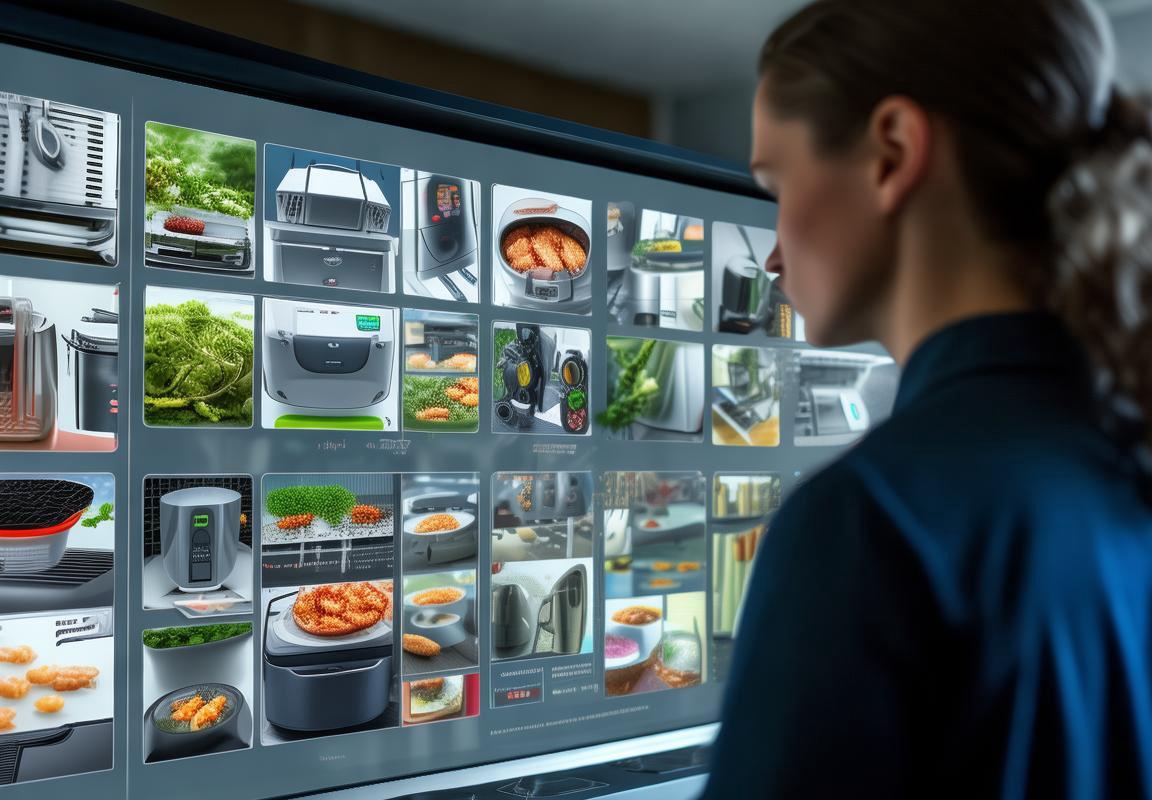
Case Studies: Successful Electric Grill Brands in Europe and the U.S
The electric grill market has seen a surge in popularity, with brands like George Foreman, Weber, and Char-Broil leading the charge. These brands have not only capitalized on the convenience and efficiency of electric grills but have also introduced innovations that cater to a wide range of consumer preferences. Let’s delve into some of the key players and their strategies in the European and U.S. markets.
George Foreman, known for its sleek design and health-conscious branding, has become a household name in the electric grill industry. The brand’s focus on grilling without the mess of traditional barbecue methods has resonated with health-conscious consumers. In Europe, George Foreman has expanded its market share by offering a variety of grill sizes and features, including non-stick surfaces and adjustable heat settings. Similarly, in the U.S., the brand has leveraged its strong brand identity to appeal to a diverse consumer base, from single individuals to families.
Weber, on the other hand, has a more traditional barbecue background, but has successfully transitioned into the electric grill market. Their electric grills are designed with the same attention to detail and quality that their charcoal and gas grills are known for. In Europe, Weber has tapped into the outdoor lifestyle trend by offering electric grills that are portable and easy to use. In the U.S., the brand has expanded its offerings to include electric grills with advanced temperature control systems, which cater to the needs of serious grill enthusiasts.
Char-Broil has also made a name for itself in the electric grill space, particularly with their value-driven approach. The brand offers a range of electric grills that cater to different budgets and cooking needs. In Europe, Char-Broil has gained popularity by offering affordable yet durable grills that are perfect for apartment dwellers or those with limited outdoor space. In the U.S., the brand has expanded its line to include smart grills that can be controlled via a smartphone app, appealing to tech-savvy consumers.
Innovation in design and functionality has been a key factor in the success of electric grill brands. For instance, the introduction of digital temperature control has made it easier for consumers to achieve consistent cooking results. Some models now come with built-in thermometers, which provide real-time feedback on the grill’s temperature. This feature is particularly appealing to those who want to replicate the perfect barbecue experience at home.
Another innovation that has caught on is the inclusion of multiple cooking surfaces. Electric grills with reversible plates, which can switch between a flat grilling surface and a ridged barbecue surface, offer versatility that traditional grills cannot match. This allows consumers to cook a variety of foods, from steaks to vegetables, all on the same grill.
In the European market, there is a growing trend towards eco-friendly and sustainable products. As a result, many electric grill brands are now offering models that are energy-efficient and have a smaller carbon footprint. This shift is not only appealing to environmentally conscious consumers but also to those looking to save on energy costs.
In the U.S., the focus has been more on convenience and technology. Smart grills that can be controlled remotely, or those that integrate with home automation systems, are becoming increasingly popular. These features not only enhance the cooking experience but also add a layer of convenience that traditional grills cannot offer.
Despite the rise in popularity, the electric grill industry faces challenges. One of the main challenges is the perception that electric grills cannot produce the same smoky flavor as traditional barbecue methods. To address this, some brands are now offering electric grills with smoking capabilities, such as the Char-Broil Signature Series Electric Grill with Smoker Box.
Another challenge is the competition from other cooking appliances, such as indoor ovens and outdoor gas grills. To stay ahead, electric grill brands must continue to innovate and offer unique features that set them apart from other cooking options.
The opportunities in the electric grill industry are vast. As consumer preferences evolve, there is a growing demand for healthier, more convenient, and environmentally friendly cooking solutions. Brands that can adapt to these changing preferences and offer innovative products will find success in the market.
In Europe, the demand for electric grills is driven by urbanization and the desire for outdoor cooking without the hassle of traditional barbecue methods. The U.S. market, on the other hand, is seeing an increase in demand from consumers looking for the latest technology and convenience features.
In conclusion, the success of electric grill brands in Europe and the U.S. is a testament to their ability to understand and cater to consumer needs. By focusing on innovation, sustainability, and convenience, these brands have managed to carve out a niche in the competitive cooking appliance market. As the industry continues to grow, it will be interesting to see how these brands evolve and what new trends they will introduce to keep consumers coming back for more.